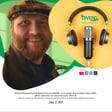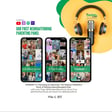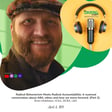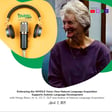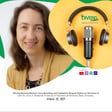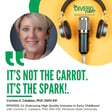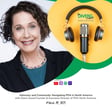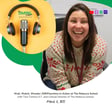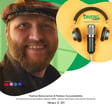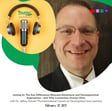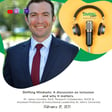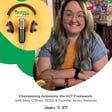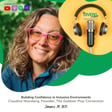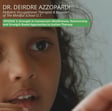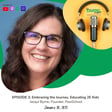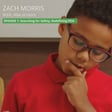Become a Creator today!Start creating today - Share your story with the world!
Start for free
00:00:00
00:00:01

Episode 15: What’s Good For One Is Good For All: A Practical Look At Inclusion
Sam Drezin, Founder & Executive Director of Changing Perspectives
In this inspiring episode, we sit down with Sam Drazin, educator, speaker, and founder of Changing Perspectives—a nonprofit organization dedicated to fostering social-emotional learning (SEL) and promoting inclusive school communities. Sam shares his personal journey and the pivotal experiences that led him to create Changing Perspectives, as well as insights into why SEL and disability awareness are critical to creating compassionate, equitable learning environments.
We dive into how Changing Perspectives helps schools integrate empathy-building programs, the importance of embracing diversity in all its forms, and actionable ways educators and communities can champion inclusion. Whether you're a parent, teacher, or advocate, this conversation will leave you feeling empowered to rethink how we nurture understanding and belonging in our schools—and beyond.
Changing Perspectives Website
Social-Emotional Learning and Disability Awareness Curriculum
Transcript
Introduction to Inclusive School Practices
00:00:00
Speaker
are these universal accommodations that support access and opportunity for all students. We're working with another school right now, and they have added a whole bunch of different activities out of recess.
00:00:15
Speaker
When we think about social inclusion, one of the things we always look for when we go to a school is what we call diversity of play. If you go outside to a traditional American playground,
00:00:29
Speaker
For recess, students usually have three choices. One, there is a sport usually involving balls of swords. Two, there is the play structure. Three, you're sitting around.
00:00:43
Speaker
right Those are your three choices. That is not cultivating an inclusive experience socially for all students. And so we worked with another school where they started a bubble station. They started a dance station where they play music and kids can come and dance.
00:00:58
Speaker
They created an alternative recess space inside in one of the classrooms where kids can come and play board games or finger paint. They pre up provided sidewalk chalk for kids to draw, right?
00:01:10
Speaker
So we're looking at kind of more of that social model lens of, okay, what already exists, how are some students not able to access or participate with what exists, and how do we add things, and we might be adding it for one student, but you know what?
The Diverge Podcast and Its Mission
00:01:27
Speaker
Actually, a lot of the kids who play soccer, Love taking a break from soccer and dancing for a few minutes in the middle of places, right? And looking at all those opportunities. Welcome to the Diverge podcast, inclusive of autistic and other neurodivergent voices.
00:01:42
Speaker
We exist to bridge the gap between specialized knowledge and everyday parenting. We are on a mission to bring together the most forward thinking experts who are deep in the trenches, championing neuroaffirming and developmentally based approaches to therapy, to education and life.
Creating Inclusive Learning Environments
00:01:59
Speaker
Designed for parents, educators, friends, and allies. Conversation by conversation, insight by insight, we are building community and making space for all kinds of minds.
00:02:11
Speaker
Hi, everyone. Welcome to the Diverge podcast. Today on the podcast, we have a very special guest, Sam Drazen. He is the founder and executive director of Changing Perspectives. And Changing Perspectives is a nonprofit that I've been able to serve on the board of for a couple of years now that focuses on creating inclusive learning communities.
00:02:31
Speaker
And what I love about the work of Changing Perspectives is that it's very much boots on the ground. The focus of the organization is about training teachers and equipping districts with an SEL and inclusion curriculum that really allows students with disabilities to find belonging and community within their schools.
00:02:51
Speaker
Today's podcast really focuses on some practical and tactical ways that parents can advocate for more inclusion via the IEP process, what it might look like to advocate for more social inclusion, all the way down to what happens on the playground, um and really how we can shift to a mindset that's going the process.
00:03:10
Speaker
that really focuses on creating belonging for all kids. I find this to be a really diplomatic and amazing conversation um that addresses some of the sticky points, but really moves in a positive direction. So please take a listen.
Sam Drazen's Personal and Professional Journey
00:03:24
Speaker
If you have questions, feel free to reach out and we will talk to you at the end of the podcast.
00:03:30
Speaker
Hi, everyone. Today on the podcast, we have Sam Dresen. He is the Executive Director of Changing Perspectives and an educator in his own right. So really excited to talk to him about what he is built with Changing Perspectives and also his insight, not just around inclusion, um and disability inclusion in school, but also around SEL, which is a buzzword that I find most parents ah don't know a ton about, which is social and emotional learning. So we're going to break that down as well.
00:03:59
Speaker
um I will let Sam introduce himself and we will get into it. All right. Thanks, Christy. Thanks so much for inviting me on to your podcast today. I'm so excited. Oh, where do I begin? I've done a lot of different things. I started my career as a special education paraeducator. From that, I became a general education classroom teacher at the elementary level. I taught third grade and fifth
The Importance of Mindset in Education
00:04:25
Speaker
grade. Oh, fun.
00:04:26
Speaker
And about 10 years ago, i started changing perspectives and national educational nonprofit organization, partnering and collaborating with schools and districts to support them in their inclusion journey.
00:04:41
Speaker
Very, very cool. That's amazing. um And what brought you to the field of education? So I was born with a rare facial difference called Treacher Collins syndrome.
00:04:53
Speaker
um And as a kid, kind of looking different and feeling different and living with a hearing loss um from a very young age, I always felt much more, um,
00:05:06
Speaker
aware of my school experience, I think, than other kids. And so i kind of really wanted to pursue so working in education um as a way to really help other kids hopefully feel less socially isolated and more included than I did in my own school experience. was really a reflection on my own K-12 career and the challenges that I experienced in terms of teachers supporting me and peers, including me.
00:05:38
Speaker
um And so knew that they wanted to do something to make it for make it better for for other students.
Implementing SEL and Inclusive Practices
00:05:46
Speaker
That's amazing. um And one of the questions I often ask, which is not in our list, and I apologize.
00:05:53
Speaker
um But when it comes to the world of disability education, inclusion, ah SEL, if you could wave a magic wand, and change anything, what would it be?
00:06:05
Speaker
At the end of the day, it really all comes down to mindset. Yeah. Um, and so, you know, a lot of times when I do trainings for teachers, they always just say, well, just tell me what to do. Give me the tools. What do I do to support this autism? Or what do you want me to do to come up with a behavior implementation plan?
00:06:24
Speaker
And I never give teachers tools right away because if they don't have an inclusive mindset, to begin with, if they don't have a mindset and value system that social emotional learning is not one more thing, it is a part of everything you are doing as a teacher, there's no point in giving them tools. So I think my magic wand would be to create a mindset that is inclusive of all things.
00:06:53
Speaker
And is asset focused as well as helping folks think about this work as not one other thing, but really just another layer of what they're already doing.
00:07:06
Speaker
ah Love that perspective for two reasons. One, we just launched a podcast this week with a friend of mine who works with the NJCIE. Sorry, I always mess up the acronym to anyone who's listening, um but it's an organization focused on inclusion in New Jersey.
00:07:24
Speaker
um And he's also an academic whose primary focus has been inclusion. And his answer was the same. It is all about mindset. um And then the second reason is because...
00:07:35
Speaker
trying to live in the world of neuroaffirming therapies when you have an autistic kid, there is this temptation that I have talked about a thousand times of trying to coach certain therapists like through things with tools and tips and tricks.
00:07:49
Speaker
And over the last couple of years, I've learned to just be quiet and let people tell me how they think about my kid and the therapy and the philosophy and
Benefits of Inclusion for All Students
00:07:58
Speaker
the approach. Because if they're not already there...
00:08:02
Speaker
it's not going to work anyway. So that's something we talk about from a completely different sort of um vantage point um is letting people teach you. When I work with schools, there's two components of an inclusive mindset that are so vital. One is meet people where they're at.
00:08:21
Speaker
ah And two, start with your allies. And so when Changing Perspectives goes in and and starts our work with a new school that we haven't worked with before, it really is about assessing where is everyone. Mm-hmm. in their own journey of cultivating an inclusive mindset and who are allies that we're going to start with.
00:08:43
Speaker
Very cool. That's actually really good to hear. um So talk to me a little bit more about, Changing Perspective does does focus on work around inclusion and SEL, but just to kind of ground, what's inclusion and what's SEL, if they're new terms for anyone listening?
00:09:02
Speaker
So I'll start with SEL and I would say before I share my definitions, I would say there are probably hundreds of other definitions. So this is the way that I see it. This is the way of changing perspectives.
00:09:15
Speaker
We, ah you know, kind of come to this work. So I think about social emotional learning SEL as a set of transferable universal skills that we use throughout our entire lives.
00:09:28
Speaker
Oh, I like that. tough Universal and transferable skills. There's an organization with the acronym CASEL, the Collaborative of Academic and Social Emotional Learning.
00:09:40
Speaker
They have unpacked social emotional learning into five competencies. ah Self-awareness, self-management, social awareness, relationship skills, and responsible decision making.
00:09:54
Speaker
Wow. Within each of those competencies or buckets, there is then a set
Advocacy for Inclusive Practices in Schools
00:10:01
Speaker
of skill sets and concepts. So again, i think about it as a set of transferable universal skills and that we can organize those skills into those five different areas. Right.
00:10:15
Speaker
Got it. That's really helpful. And then, you know, just to kind of push this a little further, when it ah when it comes to SEL and specifically ah SEL in the classroom, how do these things set kids up very for learning?
00:10:30
Speaker
as As parents, I feel like we're we're told that our kids need a certain amount of skills before they show up so that they can learn. But this really feels like a tool to help the learning process as a whole.
00:10:42
Speaker
So I really like to unpack things. so I'm going to unpack that a little further. Great. I like to think about SEL in two different areas. There is proactive SEL and there's a reactive SEL.
00:10:55
Speaker
Okay. So proactive ah SEL are those times where teachers are teaching an explicit SEL skill. So for example, it's, you know, when the teacher gathers the students and is doing a lesson on conflict resolution, right? And they go through a role play and they do that, right?
00:11:13
Speaker
So that'd be explicit SEL. There's also what I call reactive SEL. Reactive SEL is when students are in a conflict
Services and Goals of Changing Perspectives
00:11:21
Speaker
at recess and someone on recess supervision is going over and trying to facilitate students resolving the conflict.
00:11:30
Speaker
Now, you cannot... Resolve the conflict on recess if you don't have the skills that you should have been taught during an explicit time, right? We know that students, as human beings, we can be in two different frames of mind. We can be in the learning brain or we can be in survival brain.
00:11:48
Speaker
right Learning brain is when we're regulated, when we're in a sensory calm environment, when we feel physically and emotionally safe and we're receptive to new information. yeah Survival brain is when we are dysregulated.
00:12:03
Speaker
Maybe we're feeling unsafe, unheard. uncomfortable in some way, and we're not going to be receptive. And so I think the challenge that a lot of schools struggle with is that they don't do enough of what I would call the proactive SEL instruction.
00:12:22
Speaker
Correct. and And they're spinning in circles all the time with reactive SEL facilitation. Right. And so it really is this balancing act that schools need to think about and be incredibly intentional about in terms of what are the time, space, resources,
Universal Design for Learning (UDL) and Accessibility
00:12:41
Speaker
people power to provide that explicit ah SEL instruction order to then facilitate those skill sets so students can, for example, resolve conflicts by themselves at recess.
00:12:55
Speaker
Right. Right. No, that's actually a really good breakdown. And further, ah to take it ah ah one step further
00:13:05
Speaker
Do you see, one of the things I have noticed, and I think we talked about this before we jumped on, um in our journey, I'm going to say hopefully no one will come for me, kids with more behavioral-based disabilities, right, where there are a lot of behaviors, whether it's sensory-driven or things like that.
00:13:23
Speaker
I have often noticed in certain environments, there is not a lot of proactive behaviors. conversation. um there's There's not a lot of SEL from to the extent of like, this kid has the capacity hear me or understand this prior to getting into a situation. Do you see that like ah across the board?
00:13:45
Speaker
Is that common or is it specific to, in this case, like autism as a disability? No, that really is across the board. Whether we're talking about students with disabilities, whether we're talking about English language learners, whether we're talking about students have experienced trauma, most of the SEL curriculums that schools are going to purchase and implement as part of those kind of proactive SEL instructional times are designed for the neurotypical
00:14:20
Speaker
middle, middle, upper class, right? Student, right? and So we have curriculums that are designed for a specific student. I'll give you just like a perfect example.
00:14:33
Speaker
um One of the districts that we support is at Changing Perspectives was using an SEL curriculum. And they were ah serving, you know, it's a 10-01 school serving a lot of students of of very low socioeconomic households.
00:14:53
Speaker
And the the teacher was saying to me, like, oh, we're just having such a hard time with he with the students understanding emotions. And so we started to dive a little deeper into it. And the curriculum that they were using to teach emotions was using waves in the ocean as the analogy.
00:15:12
Speaker
Now, none of the students in the class have ever seen the ocean. Right. So they're using an analogy that is not relevant
Expanding Impact of Changing Perspectives
00:15:21
Speaker
to the lived experience of students.
00:15:24
Speaker
And so whether that's related to so socioeconomic challenges that these students haven't had the ability to go visit the ocean or whether we're talking about our neurodiverse students who perceive the world in a different way.
00:15:41
Speaker
So much of social emotional learning is having kids reflect their current and past lived experiences. Right.
00:15:51
Speaker
And so if you experience the world or perceive information in a different way than your peers, it's very hard for you to connect to that more sort of canned social emotional learning curriculum or instruction.
00:16:06
Speaker
Right. That makes total sense. Yeah. ah Great analogy too, by the way. How does the work of changing perspectives, I'd say this, since we talked a lot about SEL, benefit ultimately creating more inclusive classrooms?
00:16:21
Speaker
So I'm going unpack this further. That's what i like about you. Yeah, we're always unpacking. So just like we unpacked social emotional learning into those five competencies of self-awareness, self-management, social awareness, relationship skills, and decision-making, I like to unpack inclusion into three areas.
00:16:42
Speaker
Because as you said earlier on this episode, Christy, like inclusion, SEL, like these are buzzwords in today's world in education. And we very rarely actually sit down and unpack them and go, what does this really mean?
00:16:56
Speaker
What does it mean for me as a parent? What does it mean for my child? What does it mean for me as an educator? um So I like to think about inclusion in three different areas. um Academic inclusion. So we're thinking about students' ability to access content and participate in the learning experience.
00:17:13
Speaker
Right. Physical inclusion, which is things like not just ADA accessibility, but, um, ah providing a sensory calm environment, thinking about the design of places and spaces, thinking about having calming corners in your classroom, et cetera, et cetera.
00:17:29
Speaker
And then we also have social inclusion, right? Social inclusion, meaning I'm creating communities where all students feel a sense of belonging, where um students feel safe, where diversity is valued, where disability or differences looked at as an asset, not a deficit.
00:17:48
Speaker
Right. Right. We these three areas of inclusion that sort of play together. When we think about the intersection of social emotional learning and inclusion, i think a really about that social inclusion bucket connecting with those five competencies of social emotional learning.
00:18:08
Speaker
Got it. That makes a lot of sense. um And kind of breaking down even further, because we have, but we as I mentioned before we jumped on the podcast, I live in New Jersey.
00:18:20
Speaker
There's a decent listener base in New Jersey, a lot for the whole United States. um And for those of us who have kids with higher support needs, they automatically get shuffled into self-contained classrooms because our state loves a self-contained classroom.
00:18:34
Speaker
our director of special education in my town will tell you how proud this state is of championing the self-contained classroom 30 years ago or however long it was. um And a lot of times what happens specifically around inclusion is it's hard to have people really diplomatic conversations because as parents, we know what kind of support our kids are or aren't getting maybe in these self-contained classrooms. Right.
00:19:01
Speaker
um And we have a district that's sort of like telling us one story versus another. From an advocacy perspective, do you have opinions on what parents should be fighting for?
00:19:18
Speaker
So that's a really big question. And I pause to kind of think about how I want to respond to such a large question.
00:19:30
Speaker
I run an educational nonprofit that promotes and supports and works with districts and schools to move away from And to minimize the need for our self-contained classrooms, because the reality is the world is not made up of self-contained and general education classrooms, right? When you walk into a store, it doesn't say, okay, if you live, if you're neurodiverse, you shop in these aisles and everyone else you shop in these aisles, right? Right. Right.
00:20:02
Speaker
A huge component of social emotional learning is also learning about understanding multiple perspectives, learning how to communicate and collaborate and solve problems and socialize with people that are different from you.
00:20:21
Speaker
With that being said, however, I do know of parents who are stronger advocates of a self-contained environment for their students.
00:20:33
Speaker
And so the way that I like to think about it is when we think about inclusion in those three buckets, academic, physical, and social. Mm-hmm. a truly beneficial inclusive experience needs to be either academically, socially, emotionally, and or physically beneficial to both the student who is being mainstreamed and for his, her, or their peers.
00:21:02
Speaker
And so it's all about thinking about what are the needs of the student right And what are the appropriate time, places, and spaces during the school day where inclusion is going to be beneficial?
00:21:21
Speaker
right right We're not just going to include everyone for the sake of including everyone, but we're thinking with intentionality why Sam should be a part of morning meeting in his gen ed classroom.
00:21:37
Speaker
Right. um And so for some students, that means that what's best for them is to receive push and support all day and be a part of the gen ed classroom.
00:21:49
Speaker
great For other students, that might mean that there are certain times, places and spaces of the day that they are a part of that community. And then there are other time spaces and places where a pullout model is going to be a greater benefit for them to achieve the skills that they're working on.
00:22:10
Speaker
right And so I think a lot of times there's like this one or the other. Absolutely. Really, I think is a mixed model approach because we're talking about human beings.
00:22:22
Speaker
We're talking about people and it may change. As our students change, as they grow, as they change to different schools. So I always go back to this idea of what are the benefits of inclusion for student A during each time of the school day, each part of the school day, and then breaking it down further and going, what is the benefit academically for that individual And their peers, what is the benefit socially for that individual and their peers? I think you get the idea.
00:22:56
Speaker
Absolutely. Yes. And I love the way that you've described it, because what I find often happens as a parent is you're sitting in the seat and you almost push yourself into a bucket of being pro inclusion no. Right.
00:23:09
Speaker
no Right. And so you have parents who are comfortable with their kids placement and are maybe doing a few inclusive things, but not all. And I think they get nervous. And I was one of these parents about fighting for a district wide perspective on inclusion. And that's bigger than what's being offered to them because they've advocated for what works in their situation.
00:23:33
Speaker
um and and what I often find is so much gets lost in translation. Like if you live in a state that does not work, champion inclusion as a whole, there's a lot that parents just don't know. And so for us to like divide ourselves into camps essentially doesn't further the conversation.
00:23:50
Speaker
So that's more of what I was kind of getting at is like, what are we pushing for at the district level? I think one of the things I wish we had were like in an IEP, like specific inclusion goals, because a lot of times in an IEP, it's like, oh, the student is going to be included X number of minutes a week.
00:24:08
Speaker
OK, but why and what does that look like? Does that look like a student with their one on one just sitting in the back of the classroom and they're included? Or they're sitting in the cafeteria at the same time everyone else is eating, but they're off by themselves, right?
00:24:24
Speaker
Right. I'm a big proponent of like, we're not just adding in minutes of inclusion for the sake of adding in minutes of inclusion. That makes a lot of sense. What is the goal for it?
00:24:35
Speaker
What is this the student's goal? How is this furthering their other IEP goals? Right. And I don't know that I've ever seen anyone say, and how is it benefiting the other students? I've heard a lot of like, how's it going to detract, but never like, what is the benefit to the other students? So I think that's, ah both of those are really practical applications of inclusion and pushing districts a little harder.
00:24:58
Speaker
um I'm trying to be, oh, go ahead. me When we think about this idea idea of social emotional learning too, right? Like, Inclusion doesn't just benefit the student with a disability, right? It's not all helps all students see all students their peers.
00:25:16
Speaker
And so how are we creating intentionally creating opportunities to foster collaboration, communication skills, friendship skills, all of that amongst everyone.
00:25:28
Speaker
Absolutely. And I say that often because, you know, we live in an area where everybody wants to send their kid to Harvard. And I'm like, if your kid is going to run a company, they're going to need to know how to work with different types of people.
00:25:40
Speaker
like So it's helping us all. No, I think those are great points. So talk a little bit more practically about the work that Changing Perspectives does. i'm I'm familiar with it because I'm on the board, but would love for people to kind of understand what you're doing when you're going into districts.
00:25:55
Speaker
Yeah, the way that I describe it is essentially we're a direct service organization. So we have five programs and services that we offer. um We are an la carte menu.
00:26:07
Speaker
So we are not an organization that comes in and says, if you're working with changing perspectives, you have to do step one through step 20. We come in and we get to know the school and understand where they're at in their either inclusion or social emotional journey, and then kind of put together a plan for how we can continue to facilitate it.
00:26:32
Speaker
You'll notice that I use the word journey very intentionally, right? Because we know one of the components of an inclusive mindset is there is no finish line, right? This really is a journey. That's amazing.
00:26:45
Speaker
um And so what we do at Changing Perspectives is we do have a social emotional learning curriculum, as well as what we call a disability awareness curriculum. that is one of our offerings is providing schools access to these curricular resources.
00:27:00
Speaker
We don't go in and teach the kids the curriculum. We are empowering the teachers, right? Because one of the cornerstones of a truly inclusive school community is one in which all students view all adults as their teachers, right?
00:27:17
Speaker
And all adults view all students as their students. Right. And so we don't want to come in and do it. We want to empower and educate and inspire and build confidence in the staff at the school to own this work every day.
00:27:34
Speaker
That's amazing. Yeah. So we have our curriculum resources. We also provide professional development trainings. We provide ongoing coaching support to educators, administrators, paraeducators.
00:27:47
Speaker
We do family engagement workshops where we'll go to a school and facilitate or co-facilitate with members of the school team, ah family engagement workshop to educate family members on these issues.
00:27:59
Speaker
I mean, we also do what we call site visits, where when we'll go in, um but we'll do observations, we'll do sort of an audit or an assessment of where the school is, and then make recommendations for how they can continue to move the needle to where they're trying to go.
00:28:14
Speaker
Got it. Amazing. um I might come back to that in a second, but it sparked a question. Have you ever been in a situation where you've dealt with kids who ah potentially have some trauma around learning?
00:28:30
Speaker
and the markers that would often have people say like, oh, they should be in a self-contained classroom. When in reality, they would do a lot better in a space where you're creating safety around learning in maybe a fun, more inclusive gen ed environment. And if so, can you talk about it?
00:28:52
Speaker
So I'm going to answer your question like a classic consultant without really answering your question. Yeah.
00:29:03
Speaker
Two things happen when you're trying to kind of, as I like to describe, agitate a system a little bit. Yep. Inclusion, especially students who may have more behavioral needs, right requires general education educators in special education educators to collaborate and communicate in ways that they don't need to do if it's more of the self-contained model.
00:29:35
Speaker
Right? If it's self-contained, the special educators just doing their thing, the gen ed teachers doing their thing, they don't have to communicate. right Soon as we force systems to collaborate and communicate more consistently and in different ways, right that can really, really trigger people.
00:29:57
Speaker
And that is forcing the adults in the system to move from maybe a fixed mindset on how to support the student to a growth mindset. right And that in itself is a huge hurdle to overcome.
00:30:12
Speaker
Now, with that, it we also know that all behavior is communication. Yep. Okay. All behavior is communication.
00:30:24
Speaker
Right. Right. But in systems where the focus is reaction, where are the focus is putting out fires, where the focus is, how do we get through the day, where the focus is, how do we just get as many students to be proficient in x y and Z subject to score to a certain arbitrary level on a test?
00:30:47
Speaker
Yeah. Taking the time to collaborate and communicate. Reflect on what the behavior is communicating.
00:30:57
Speaker
Yeah. Change an environment, change an approach to meet the need of that one student. is often where it just gets so overwhelming.
00:31:12
Speaker
There's not enough times time in the day. and it just, it's so much easier and simpler to go to the us and them sort of model to keep the bus moving.
00:31:26
Speaker
Now, I think one of the ways, there's a couple of solutions to this problem. So one of the solutions is that we need to change our mindsets to more of a universal design for learning mindset. i don't know if you're familiar with UDL.
00:31:43
Speaker
I am, and I love it. and Please talk as much about it as you would like.
00:31:50
Speaker
So UDL is a very constant, it can be very confusing. And I think sometimes people assume that UDL is a curriculum, right? UDL is not a curriculum.
00:32:01
Speaker
UDL is a framework. One of the pieces of UDL that i'm going to talk about right now, because it relates to what we're discussing on this episode, is that anything you do for one can help many.
00:32:15
Speaker
Yes. Yes, yes, please. Right? Yeah. So anything that we might do to augment a learning experience, to redesign a classroom, and we might be doing it for one student, but ultimately it's going to help many students.
00:32:34
Speaker
Mm-hmm. But in our current model, we don't think about it that way because we think about disability from a medical model. We think about disability as a deficit. So it's like, why would we change this for one kid who just can't sit still?
00:32:51
Speaker
Right. When I've got 20 other kids who can sit still. Right. Rather than thinking about, huh, if I change this for this one kid, right?
00:33:01
Speaker
who are all the other kids that could benefit? So the classic example of UDL is the curb cut effect, right? So the curb cut is how our sidewalks kind of go down to a little ramp ah to connect to a crosswalk.
00:33:16
Speaker
Now, the curb cut was a result of ADA, Americans with Disabilities Act, to ensure that f crosswalks were accessible to those with physical disabilities, right? If you're in a wheelchair, there's no way you could get from the curb to the crosswalk without a cut in the sidewalk.
00:33:33
Speaker
Yes. And there's there's lots of illustrations out there. You know if you just Google Kirk cut effect, you could see all these illustrations. You really think about it. Think of all the people.
00:33:44
Speaker
that the curb cut makes the sidewalk more accessible for, right? Elderly, people um pushing strollers, ye people on skateboards, scooters, bikes, people that are delivering packages, right? So this one little change in how we pour the concrete,
00:34:03
Speaker
From our sidewalks to our crosswalks that was done for one group of individuals, individuals with physical disabilities helps everyone. Right.
00:34:14
Speaker
And so we have to get out of this mindset in schools of like, oh, we're just doing this for one kid. Right. But we need to get into the mindset of what is the student communicating?
00:34:27
Speaker
What could be the unmet need? How do we fill that gap? And who are all the other students? Who else is going to benefit from it? Yes. And I love that you use the example of sitting still, but even something as simple as visuals.
00:34:40
Speaker
My son, for the longest time, despised visuals. And I'm fairly confident it was because it was being like pushed in front of him in a very isolating, I'm the only kid who needs this sort of way.
00:34:53
Speaker
Whereas I'm the most visual person you'll ever meet. Like we all need visuals, right? So just want to make sure parents understand it's it's bigger than just like sitting still. It's a lot of like learning tools.
00:35:04
Speaker
Multisensory reading is another great example. um There's a lot out there, but it's not, it's not well talked about. So thank you for breaking that down. Yeah. So that's amazing. And then, you know, we talk about a lot since we're we're going deep on inclusion in terms of of tiers of support.
00:35:20
Speaker
um And with the work of, you know, that you guys do with changing perspectives, have you seen um maybe a change in some of your districts and how they approach tiers of support and how they think about that?
00:35:34
Speaker
Because they have a ah curriculum that works better for everyone. Yeah.
00:35:42
Speaker
So we've I've so many examples I could share and I know we only have a limited amount of time. um
00:35:50
Speaker
Yeah. So when we think about tiered support, I think of multi-tiered systems of support or also known as MTSS. Just throw out more educational acronyms today. know there's a lot of acronyms in that education. There are so many acronyms. You guys love them.
00:36:08
Speaker
Ultimately, I think one of the challenges we really need to see our students who receive special education services as tier one students first. Right. They are gen ed students first.
00:36:21
Speaker
um I'm trying really hard to help schools change their language. Right. That we're not saying our sped students. Right. we're saying our students who receive services, right? Because special education isn't a place or it shouldn't be in my mind, a place that we send kids.
00:36:38
Speaker
It's a service that we ah provide or is offered. And that service can be provided in so many different places and spaces and ways, right?
00:36:49
Speaker
Why couldn't a student who receives occupational therapy support, do OT during recess and invite a gen ed friend to play with them. Absolutely. Yes. There are so many different ways that support could be provided and it doesn't need to be always in sort of that segregated exclusionary way.
00:37:11
Speaker
Right. A couple of examples I can share. um One school that we're working with, we have been working really hard on visuals um and really helping all teachers have more visuals in their classroom. The way that we're phrasing it is universal accommodations, right? What are those things that are universal, right? And talking to teachers. If you have a word wall in your classroom, that is an accommodation for everyone.
00:37:38
Speaker
If you have a number going across the border of your classroom, that is an accommodation for everyone, right? There are these universal accommodations that support access and operate opportunity for all students.
00:37:52
Speaker
Mm-hmm. Right. We're working with another school right now, um and they have added a whole bunch of different activities out of recess.
00:38:03
Speaker
When we think about social inclusion, one of the things we always look for when we go to a school is what we call diversity of play. If you go outside to a traditional American playground for recess, students usually have three choices.
00:38:21
Speaker
One, there is a sport usually involving balls of sorts. Right. Two, there is the play structure. Yep. Three, you're sitting around.
00:38:33
Speaker
Yep. Right. Those are your three choices, right? Mm-hmm.
00:38:38
Speaker
That is not cultivating an inclusive experience socially for all students. And so we worked with another school where they started a bubble station. They started a dance station where they play music and kids can come and dance.
00:38:51
Speaker
That's so cool. Yeah. They created an alternative recess space inside in one of the classrooms where kids can come and play board games or finger paint. Right.
00:39:02
Speaker
They yeah provided sidewalk chalk for kids to draw. Right. So we're looking at kind of more of that social model lens of, okay, what already exists How are some students not able to access or participate with what exists and how to add things? And we might be adding it for one student, but you know what?
00:39:23
Speaker
Actually, a lot of the kids who play soccer love taking a break from soccer and dancing for a few minutes in the middle of recess, right? And looking at all those opportunities. That's such a cool example, primarily because it echoes something I have noticed with my son. And it took about a year. we go to these like nature school classes.
00:39:44
Speaker
And there are times when he's all in like with the kids doing certain things. And there are times he doesn't really care. And after a while, I started stepping back and looking at like what are the things that he like readily participates in with more, you know, social happening while he's doing it.
00:39:59
Speaker
And the through line through all of them was it's a super physical activity. It's really easy to understand what's going to happen to you and what's expected of you because what's happening is very physical. So hikes,
00:40:12
Speaker
snowball fights, getting out the spray bottles. Bubbles was another one that was like a big hit. um One time someone was building like a giant snowball and he walked up to them and asked if he could smash it. He'd never talked to this person before. He asked, he did not smash it when she said no, just FYI.
00:40:29
Speaker
um But it was that it's that through line that took a while to notice where it's like, no, he, he can absolutely be social and like participate But if it's not the right activity, there's too much guesswork for him. And so that's taking all of his brainpower versus just being able to jump in.
00:40:45
Speaker
So I like love that example. I had never heard that before. That's really cool. um I like the bubble stations for all. It's really cool. um So changing perspective wise, I'm trying to keep an eye on time so we don't run over.
00:40:59
Speaker
ah What are you guys working on right now so um that you're really excited about? um And what's kind of in the future?
00:41:09
Speaker
Well, I can just give you a little historical context. The first year that I started changing perspectives, which was 10 academic years ago, which is crazy to think about. We worked with 12 schools um in two states.
00:41:24
Speaker
The current year that we're in right now, um we're in well over schools in over states. So ah it's remarkable. And I'm so proud of the team that I have working with me um in not just changing perspectives and attitudes and mindsets, but changing practice.
00:41:45
Speaker
um And so we are really hoping to continue to build on the momentum of the work we've already done. um One of the things that is always fun is for us to be sort of a conduit of information, right? Like we could be working in with one school on the East Coast who does something really cool and then we share that information with school on the West Coast.
00:42:06
Speaker
um so you know, we don't have anything new that we're doing. We are just continuing to broaden the scope of what we do um and be here to be a support for schools and districts who have already started the journey and need a little support in it.
00:42:26
Speaker
or are ready to jump in um and start this journey together. And we're here to kind of be a guide and a facilitator as they think about what their goals are, what their vision is for the school um and to work alongside in partnership to make it become a reality.
00:42:43
Speaker
Very, very cool. um And I've had the privilege of sort of working with Sam for a couple years, not like working with, but on the board. And I will say one of the hardest working people have ever met. He gets a lot done um in a very short amount time. He has a good team, but he gets a lot done.
00:42:59
Speaker
um So excited to see sort of what the future holds there. And then I think just kind of another question, you know, one of the things that came up in a separate podcast where we talked about inclusion was the very specific sort of delineation of, you know, New Jersey, for example, remember.
00:43:17
Speaker
keep picking on New Jersey has really bad inclusions rate. We're number like 50. um But there might be another state that's amazing at inclusion, but it's primarily because no other services exist. And that's just where kids have to go.
00:43:30
Speaker
um So when it comes to incredible, you know, ah SEL support and inclusion, are there any districts that you think do like fantastic, everybody should model them kind of job?
00:43:48
Speaker
It's kind of hard for me to answer that question because most of the time if we're coming in, there's opportunity for growth. um So I don't know if I can name or do a shout out right now for a specific district or state or city.
00:44:03
Speaker
But I think what I can tell you is that there are several different areas. traits that fit the mold. So for districts or schools that are really ah successful when it comes to, let's say, social emotional learning, I would say a couple of things.
00:44:22
Speaker
One, their leadership believes in the work and is committed to the work. That's huge because there's always competing priorities. There's always competing initiatives.
00:44:34
Speaker
The bottom line is if we are not meeting the social, emotional needs of our students, all students, yep our students are not going to make significant academic progress.
00:44:46
Speaker
it's just that It's factual. You can look up any study and it all says you need social emotional learning to have significant academic success. So that's one thing. You need leadership who believes in it. The other thing is you need all teachers to support it. right In some districts, what I see is it's just the school counselor that comes in once a week and does a 20-minute social emotional learning lesson.
00:45:11
Speaker
Right. Yeah. the perspective from the students then is, so oh, it's just this one teacher that does ah SEL. It's only important for this 20 minutes a week. Right. Right. Yeah. Teachers, all adults need to be actively involved in the work is another component. Correct. correct And then the last component of schools I would say that really thrive and are successful with SEL are schools that integrate it into everything they do, right? It is not something that just happens at morning meeting, at the middle or high school level. It's not something that just happens at the advisory time, right?
00:45:46
Speaker
It really needs to be integrated into everything. Right. For schools that really thrive with inclusion and inclusive practices, there's a couple things. um One, all staff need to be on kind of that social model of disability mindset.
00:46:04
Speaker
Yep. Two, we need to look at disability as an asset in our communities, not a deficit. Yep. Three, we need to have common understanding, common definitions and language around inclusion. Mm-hmm.
00:46:22
Speaker
And four, we need to be really intentional about what our goals are in a given year. Right. This is a really, really big undertaking.
00:46:33
Speaker
And yeah when we jump in too quick, too fast into the deep end and think we're going to change everything in one academic year, which is like, what, 175 181 days, depending on your your state yeah it fail and when initiatives fail In the public education system, ye we go, well, that didn't work.
00:46:56
Speaker
And we move on the next thing. So I always say to schools, like one to three goals. i had it We worked with the school one year and the goal the first year was to come up with what the goals were going to be the next year.
00:47:09
Speaker
Like that's what we focused on. But we did a real deep dive into what was already happening at the school so we could come up with very clear goals for the next year. Right. That makes total sense.
00:47:21
Speaker
um It's against my sensibilities of like, if I can see it, we can build it yesterday. But I am also not a the teacher and an educator for a reason. It's not odd.
00:47:33
Speaker
But awesome. That's amazing. ah Thank you so much for that breakdown. So yeah, is there anything you kind of want to leave people with? Where can we find you? um and I also wanted to give you a chance to shout out some of the resources for teachers, even if the whole district hasn't bought in the online curriculum portal that they have access to.
00:47:53
Speaker
Yeah. anything recover yeah Yeah. So thanks Christy for the opportunity. So a quick shout out to changing perspectives. You can find us online at changing perspectives, now.org and O W. Cause we're not waiting to do this work. We're doing it now.
00:48:08
Speaker
um From there, you can also, you can sign up to our mailing list. um You can link to us on social media. um We have through our website, teachers can gain access to our website.
00:48:21
Speaker
social emotional learning, disability awareness curriculum. We also have um pages on our website for each of those additional services that we offer. but We always love connecting and hearing from schools and districts about what's working, what isn't working and how we can help.
00:48:40
Speaker
Yeah, definitely. So we'll link everything in the show notes and you guys um are absolutely welcome to check it out. ah The work that Sam and Esteem does is amazing and inspiring to watch on so many levels.
00:48:52
Speaker
Hi, everyone. Thanks so much for sticking that out. We hope you learned as much as we did and enjoyed the conversation as much as we did. um If you have any additional questions, feel free to reach out to us or changing perspectives over Instagram and DMS. You're welcome to hit up their website.
00:49:06
Speaker
And I will also link in the show notes how you can get in touch with them. If you are looking to bring them into your district for training at the district wide level, absolutely encourage you to reach out. And if you are an educator or running a program of some sort and just want access to the SEL and inclusion curriculum, you can actually purchase a subscription on the website that gives you access to the tools and resources as well.
00:49:30
Speaker
So I'll make sure that's linked. It is a really cool program and i encourage everyone to check it out. We will see you next week.

